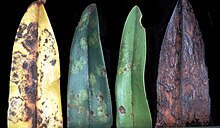Plant pathology

Plant pathology, or phytopathology, is the study of plant diseases. Like animals, plants can get infected and damaged by viruses, bacteria and fungi.
It includes not only the harm done by pathogens (infectious organisms), but also harm done by environmental conditions.[1]
Organisms which cause infectious disease include fungi, oomycetes, bacteria, plant viruses, viroids, virus-like organisms, phytoplasmas, protozoa, nematodes and parasitic plants.
Not included are ectoparasites like insects, mites, vertebrate, or other pests that affect plant health by eating plant tissues. Plant pathology involves the study of pathogen identification, disease cycles, economic impact, plant disease epidemiology, plant disease resistance, how plant diseases affect humans and animals, and how to manage plant diseases.
Plant pathology is of fundamental importance to agriculture.[2]
References
- ↑ Agrios, George N. 1972. Plant pathology. 3rd ed, New York: Academic Press.
- ↑ Aisnworth G.C. 1981. Introduction to the history of plant pathology. Cambridge University Press. ISBN 0-521-23032-2